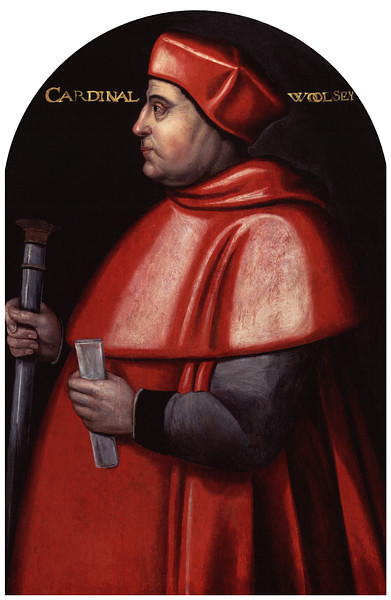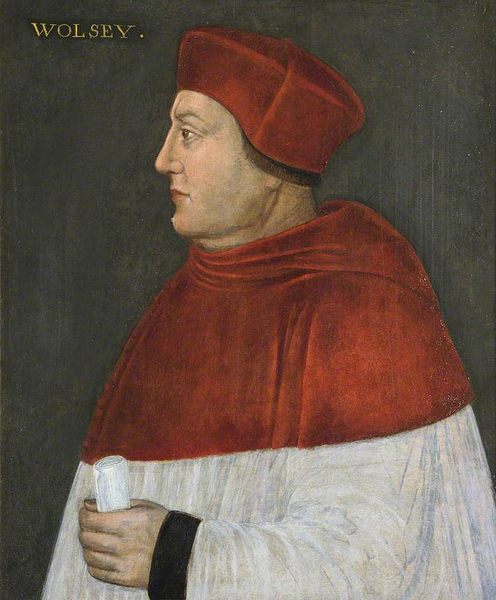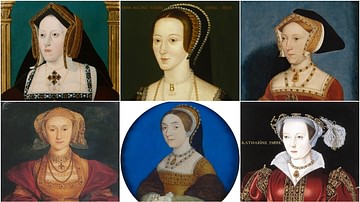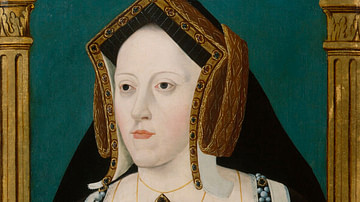
Thomas Wolsey, Cardinal Archbishop of York (l. c. 1473-1530 CE) served as Lord Chancellor to Henry VIII of England (r. 1509-1547 CE) from around 1513 CE to 1529 CE. Wolsey rose to become the most powerful man in England after the king, he created the Chancery court, worked with some success at England's foreign policy, and famously built Hampton Court Palace near London. Unable to secure from the Pope the annulment of Henry's first marriage to Catherine of Aragon (1485-1536 CE), Wolsey fell out of favour with his friend and monarch. Accused of treason, the cardinal was already seriously ill when he died on his way to imprisonment and trial in November 1530 CE.
Early Life & Rise in the Church
Thomas Wolsey was born c. 1473 CE in Ipswich, the son of a butcher. He studied at university and became the chaplain to Henry VII of England (r. 1485-1509 CE), gaining invaluable experience of Tudor politics from his sponsor, the councillor Bishop Richard Fox (1448-1528 CE). However, it was under Henry VIII that Wolsey's career really took off. Indeed, after being appointed the royal almoner (giver of alms) in 1509 CE and benefitting from the new king surrounding himself with his own advisors rather than his father's, Wolsey enjoyed a meteoric rise to power from 1514 CE. He became the bishop of Lincoln in March 1514 CE and just a few months later, in September, he was appointed archbishop of York and so became the second most powerful church official in England.
Eager to be the top man in England but realising the current Archbishop of Canterbury was secure in his position, Wolsey bypassed him by directly approaching the Pope. In 1515 CE Wolsey became a cardinal and so he now outranked even the archbishop; he was truly a 'prince of the Church.' In 1518 CE Wolsey went one step higher and became a papal legate (legatus a latere), that is a representative of the Pope himself and entitled to make decisions on his behalf. Usually, legates were given their authority for a limited time only and for a specific purpose such as an international conference. In 1524 CE, Cardinal Wolsey was given legate powers for life. Thomas could now really believe that one day, he might even be in a position to grab the very top job of Pope.
Even before these momentous ecclesiastical progressions, and much more importantly for history, Wolsey had become Lord Chancellor around 1513 CE (or perhaps 1515 CE, historians do not agree on the date). In this position, he was, in effect, Henry VIII's sole minister, the very apex of the pyramid of political power in England. Thanks to his administrative skills and good friendship with the king, Wolsey became a giant political spider with a web of subordinates that stretched into every part of the kingdom.

The [King's] Council was still consulted, but only after Wolsey and the king, in a kind of partnership, had determined policy. Wolsey would first 'move' Henry towards some idea; the King 'dreamed of it more and more'; and only then would the council be informed. Wolsey's influence seemed supreme, and his household, in its magnificence, looked a rival to the royal court. So completely did he see himself as alter rex, it was alleged, that he would say: 'The King and I would ye should do thus: the King and I do give you our hearty thanks.' His pride and splendour were legendary: crosses, pillars and poleaxes, hated symbols of his authority, were carried before him; earls and lords served him. (106)
Lord Chancellor & the 'Great Matter'
With great power comes great responsibility, and Wolsey was charged with a delicate and far from straightforward task: to secure a divorce for the king. Henry VIII had married Catherine of Aragon in June 1509 CE, but after no son was forthcoming, Henry began to look for an alternative. This he found in the young and attractive lady-in-waiting Anne Boleyn (c. 1501-1536 CE). Anne would not sleep with the king until they were married and, in any case, the king required a legitimate heir (he already had one illegitimate son). Proper procedures had to be followed and Henry first had to divorce Catherine. The Catholic Church did not allow divorce but a marriage could be annulled on certain grounds - these Henry thought he had. Catherine had married Henry's late brother Arthur (b. 1486 CE) in 1501 CE and so the king wrote a letter to Pope Clement VII (r. 1523-1534 CE) in 1527 CE suggesting that the lack of a male heir was God's punishment for Henry marrying the wife of his late brother, a point supported by the Old Testament's book of Leviticus. Consequently, the king wished for the Pope to annul the marriage because it should never have been allowed in the first place.
There were problems, though. First, in practical terms, Catherine had support both amongst commoners and nobles and even Henry's Archbishop of Canterbury was dead against a royal divorce. Secondly, there were legal and ecclesiastical arguments to counter. Being so young, it was unlikely that Catherine and Arthur had ever slept together and so the 'Prohibition of Leviticus' did not in this case apply. In addition, another passage of the Bible, this time in Deuteronomy, seemed to contradict Leviticus.
Wolsey was sent to personally see the Pope in Rome and push Henry's case. Wolsey wished to demonstrate the marriage should not have been sanctioned by Clement's predecessor and that the matter should now be delegated to him as papal legate. The cardinal even told his clerical superior that his own position was in danger if success were not met in this delicate matter. Clement was unmoved and, probably more to put off a decision than anything else, he agreed only to send another legate, Cardinal Lorenzo Campeggio to England to investigate the 'Great Matter' more thoroughly. Campeggio was instructed to take his time in reaching his destination and begin by seeing if he could not reconcile Henry and Catherine. It did not look promising for Henry or Wolsey.

The Courts
The 'Great Matter' has overshadowed Wolsey's tenure as chancellor but he was certainly a very gifted administrator and displayed boundless energy in his work. The cardinal was also quite brilliant at acquiring titles, estates, and wealth for himself. Historians estimate Wolsey was raking in 35,000 pounds a year at his peak, which was six times more than the richest peer in England. One of his lasting successes was the creation of the Chancery, the court which was independent of the usual law courts and so free from the cumbersome and inflexible common laws which few ordinary folks understood. This Chancery court was headed by the chancellor, and people were encouraged to petition him directly if they felt they had suffered a miscarriage of justice. Rulings were based on common sense and ideas of natural justice, and they were made much faster than in the normal law courts. It is rather ironic, then, that over the centuries, the Chancery built up so many conventions and rules of its own that it became infamous for its slowness and complexity, swallowing up claimants, defendants, and their wealth, as comically portrayed in such works of literature as Charles Dickens' 1852 CE Bleak House.
Another area of expansion Wolsey oversaw was to greatly increase the number of Justices of the Peace (aka JPs, local officials appointed by the Crown to enforce new laws and administer justice). Wolsey insisted JPs be regularly called to London where their actions were examined by a committee led by Wolsey himself and which was hosted in the Star Chamber of the Palace of Westminster. Wolsey also sat at a third court, the Court of Requests which was designed to give the poorest members of society access to royal justice. The cardinal, then, tirelessly sought out corruption and injustice although this did not make for a very efficient system of administration as it revolved entirely around a single individual, nor did it endear Wolsey to his colleagues. As the historian J. Morrill puts it:
…his confrontational and headmasterly style was accompanied by his ostentatious proffering of impartial justice to the poor, with the implication that they had previously received scant satisfaction from the rich. (42)
Despite the thirst for justice, it is, as seen above, also true that Wolsey used these courts for his own ends, too. Pursuing claimants against him, searching out those who had wronged him or challenged his monopoly of power, the Cardinal used the law to build up his enormous wealth and this objective seems to have always outweighed any desire for real and lasting judicial reforms. Finance, too, proved a difficult area to reform with too many vested interests from powerful nobles blocking progress in making the system more efficient and the royal spending more manageable.

Foreign Policy
Another area of success for Wolsey was foreign affairs. The cardinal managed the incredible logistics of moving armies back and forth across the Channel, beginning with the expeditionary force of 1513 CE, which captured Tournai for Henry. Next, he brokered a peace deal with France to put an end to the costly and ultimately unproductive war with that nation. A treaty was signed between the two powers on 6 August 1514 CE. As part of the deal, Henry's sister Mary (b. 1496 CE) was married off to Louis XII of France (1498-1515 CE) in 1514 CE. In 1518 CE, Henry settled for the status quo in Europe and a mutual defence agreement, the Treaty of London, was signed with France, Spain, and the Holy Roman Empire. The Netherlands and Burgundy were additional signatories as European powers for once - and admittedly only briefly - worked together for the common good of all.
Another of Wolsey's foreign successes was the Field of the Cloth of Gold, a spectacular show of pomp and pageantry held just outside Calais in June 1520 CE. The event was arranged by Wolsey as a sort of international summit meeting and included jousting, hunting, and banquets. The spectacle involved masses of luxury tents (hence its name) and was held as a magnificent if somewhat empty show of friendship between England and France: Henry and the new king, Francis I of France (r. 1515-1547 CE). Like many modern international political gatherings, the Field of the Cloth of Gold proved to be very pleasing on the eye but disappointing in its achievements.
One final foreign success for Wolsey was the 1525 CE Treaty of More, which renewed friendly relations between England and France. Despite these successes, it is, perhaps, fair to say that no treaty ever lasted very long as England was obliged to play a junior role in the ever-shifting balance of power between the Papacy and the two far-richer powers of France and the Holy Roman Empire. Henry VIII might have wished to become king of France but this was never going to happen given his kingdom's limited resources. Wolsey's real success, then, lay in his flexibility and managing to avoid isolation in Europe with all the other powers allied against England.
Hampton Court
The splendid country residence of Cardinal Wolsey was Hampton Court Palace, 19 km (12 miles) southwest of London. The spot had only a manor house to boast of and belonged to the Order of the Knights Hospitaller when Wolsey took it over in 1514 CE. When in London, Wolsey lived in Whitehall Palace. Wolsey handed Hampton Court over to his king in an unsuccessful attempt to get back into his good books after the 'Great Matter' failure. When the king visited his new home in 1529 CE he was astounded at its opulence and perhaps then realised just how much wealth Wosley had been building up in his time as Lord Chancellor.
Henry set about making the palace even grander, though, notably adding a new Great Hall and the Cloister Green Court, as well as a bowling alley and tennis courts, and improving the chapel and kitchens. Henry was so pleased with the place that he decided to live there with Anne Boleyn, and Edward VI of England (r. 1547-1553 CE) was born there. It remained a royal residence of importance up to and including the reign of George II (r. 1760-1820 CE).
The Amicable Grant
While the 'Great Matter' spelt the end of Wolsey's career, there was another failure of note during his tenure as Lord Chancellor: the Amicable Grant of 1525 CE. The grant was a tax imposed on commoners and the Church without Parliament's consent (that body was only called twice during Wolsey's term in office). A person's liability was based on an assessment of their wealth carried out by Wolsey's team of commissioners in an extensive survey, the 'general proscription' of 1522 CE. The grant was a departure from the usual fixed-rate taxes, the rates were very high, and it meant that many who had not previously paid taxes now had to do so. It is no surprise then that the tax was deeply unpopular and far from 'amicable'. These factors and the very shortage of coinage and the poor state of the economy that had motivated Wolsey to impose the tax (as well as the need to pay for another campaign in France), all bubbled up into a swell of ill-feeling towards the king and his government. Rebellions broke out, particularly in Suffolk and even London. Unlike all the other rebellions during the Tudor period, this one was successful as ministers advised the king to back down and then blame Wolsey for the whole debacle. This is what transpired and the Lord Chancellor began his slow slide from royal favour. When the 'Great Matter' proved unsolvable after many years of fruitless diplomacy, Wolsey's career went over the cliff and into oblivion.
Downfall & Death
In 1529 CE Wolsey was dismissed from his post in the Privy Council and as Lord Chancellor. Now Wolsey's permanent strategy of monopolising power and alienating sections of the nobility, along with his never-forgotten humble origins, all came home to roost. Without the king's favour to protect him, the cardinal had a long line of enemies all too eager to see his downfall. Pleading letters written by Wolsey to his king did not move Henry to change his mind. Eventually, he was accused of treason - the king being turned against his former friend by Anne Boleyn and other courtiers, although there were some grounds for the charge as the Cardinal had made contact with foreign powers since his fall from grace. Wolsey at least escaped an embarrassing show trial and the foregone conclusion of the death penalty when he died at Leicester Abbey on his way to London to face justice on 29 November 1530 CE. On news of the cardinal's death, Anne put on a palace entertainment titled The Going to Hell of Cardinal Wolsey.
Wolsey was succeeded in 1529 CE by Sir Thomas More (1478-1535 CE) as Lord Chancellor, a position he would hold until 1532 CE until he too fell out of favour with the king over his 'Great Matter'. Then Henry employed the services of Wolsey's former secretary Thomas Cromwell (l. c. 1485-1540 CE) as Lord Chancellor, and with the new Archbishop of Canterbury, Thomas Cranmer (in office 1533-1555 CE), the trio would take the radical step of splitting the Church in England from Rome, which allowed Henry to finally annul his own marriage in 1533 CE. The enormous consequences, then, of Wolsey's failure and the lack of will to compromise on the part of Henry or the Pope, ultimately led to the English Reformation.





